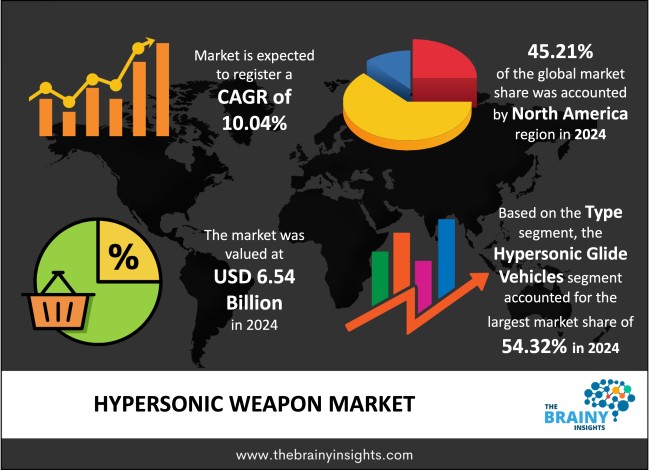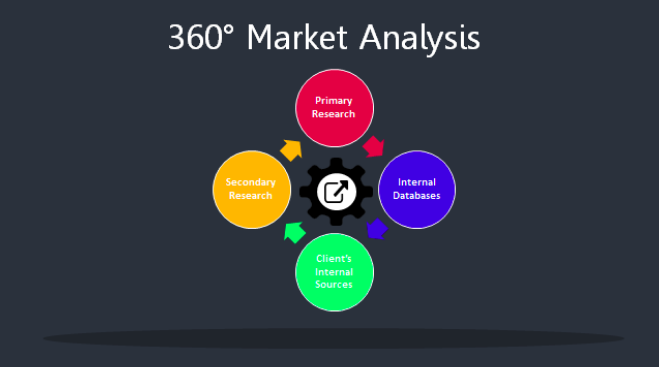- +1-315-215-1633
- sales@thebrainyinsights.com

The global Hypersonic Weapon market was valued at USD 6.54 Billion in 2024 and grew at a CAGR of 10.04% from 2025 to 2034. The market is expected to reach USD 17.02 Billion by 2034. The market is driven by factors such as a surge in the popularity of hypersonic glide vehicles and cruise missiles, as they have become a symbol of military power. Its demand is increasing with the strategic competition among countries. Hypersonic weapons can be considered as alternatives to conventional missiles or weaponry systems. It combines the benefits of manoeuvrability and speed for overcoming theatre and homeland anti-missile defence systems. Hence, it can hit the target very deep in the enemy territory or at sea. Hypersonic systems have become a symbol of power for countries that implement them and can lead to an arms race.
Hypersonic weapons are those that can travel faster than Mach 5, or 5 times the speed of sound, which is approximately 330m/s. These weapons are divided into two types: Hypersonic Glide Vehicles (HGV) and Hypersonic Cruise Missiles. The former is launched from the rocket, and it is the same as regular ballistic missiles before it glides to the target. Hypersonic cruise missiles are powered through their flight using air-breathing engines known as Scramjets after the target is set. Hypersonic glide vehicles are launched similarly to intercontinental Ballistic Missiles using the rocket booster, which boosts the hypersonic glide vehicle to a height that is below that of the trajectory of long-range ballistic missiles. The weapon is then released for re-entering the upper atmosphere and then moves towards the targets at hypersonic speed. It uses aerodynamic lift when it descends. Hypersonic cruise missiles are launched like cruise missiles with the use of a booster rocket at the initial launch phases. After that, the Supersonic Combustion Ramjet (Scramjet) engine is used. After the Scramjet ignition, the missile follows a cruise trajectory at almost constant speed and altitude. Hypersonic cruise missiles fly at lower heights in comparison to hypersonic glide vehicles and have shorter ranges.
The key benefits of hypersonic weapons are their speed, range and manoeuvrability, which make them difficult to track, target and hit. The combination of higher speed, lower trajectory and manoeuvrability results in lesser warning time for the enemy to respond. Hypersonic glide vehicles have some possible advantages over ICBMs (Intercontinental Ballistic Missiles), as they have a substantially greater range when gliding towards the target. ICBMs fall to earth following the ballistic curve after the boost phase is finished. This warfare domain is constantly evolving because of technological innovation. Advancements in technology, such as Artificial Intelligence (AI) and drones, are playing a key role in determining the outcome of war in the present age. The Ukraine war, the Israel-Hamas war and the Red Sea Crisis are all evidence of the growing use of such technologies on the battlefield. There is a growing use of the hypersonic weapons. Russia has used it at least three times in the Ukraine war. Also, Yemen’s Houthis and North Korea are claiming to have successfully tested it recently. This indicates that hypersonic weapons are expanding and will play a crucial role in future warfare.

Get an overview of this study by requesting a free sample
Growing demand for hypersonic weapons– The demand for the hypersonic weapon system is growing. Hypersonic ballistic missiles can be launched from a submarine, ground-based launcher or some other launch platform with the use of a powerful rocket booster. The booster stage provides the initial thrust necessary to propel the missile into the upper atmosphere or space. Some countries have hypersonic ballistic missiles and are focusing on the development of other types of hypersonic weapon systems. For instance, in December 2017, the Kh-47M2 Kinzhal, a hypersonic air-launched ballistic missile system, was introduced into operational service. It is one of the six new strategic weapons that Russian President Vladimir Putin revealed in March 2018. Additionally, there is increased investment in hypersonic missile programs, which are largely driven by heightened strategic competition among major powers such as the US, China, and Russia. These countries are investing in the development of advanced hypersonic weapons to increase their military capabilities and deter potential enemies. These factors are eventually propelling the growth of the Hypersonic Weapon market.
High investment – There is a requirement for high investment in the early development to fund the research, prototype, testing, and validation of hypersonic weapons. The complexity of such weapons systems leads to high development costs. Additionally, small countries face a limitation in financial resources. All these factors are acting as restraints for the market.
More investment in hypersonic programs – The focus on military modernisation has led to the development and deployment of hypersonic missile systems, as they are becoming part of a broader strategy for maintaining deterrence and preventing conflict escalation. All countries are prioritising military modernisation to gain technological superiority over potential adversaries. Hypersonic missile technology offers a cutting-edge capability with the potential to give a substantial advantage on the battlefield. There is increased investment in R&D and the acquisition of a hypersonic missile system. Additionally, promising advancements are occurring in the propulsion and guidance systems, which are enhancing speed and precision. The surge in defence budgets in several countries offers financial resources for the development, research, and deployment of hypersonic missile systems. Countries such as Australia, Brazil, the United Kingdom, France, Germany, Japan, Iran, South Korea and North Korea all have their hypersonic weapons programs. Moreover, the EU is focusing on the development of an interceptor for hypersonic missiles as it surges its defence spending to counter the Russian threat. All these factors are eventually increasing the demand for the use of Hypersonic Weapon in the forecasting period.
The regions analysed for the market include North America, Europe, South America, Asia Pacific, the Middle East, and Africa. North America emerged as the most significant global Hypersonic Weapon market, with a 45.21% market revenue share in 2024.
The North American region leads the Hypersonic Weapon market, which is attributed to the robust defence sector of the US in the region. Moreover, the US government has allocated a significant amount of funding for the development of hypersonic technologies through programs such as Long Range Hypersonic Weapons and Air-Launched Rapid Response Weapons. The country is investing a tremendous amount in the development of more advanced hypersonic systems, research, and deployment. These factors have led to a significant market share of the region for the Hypersonic Weapon market.
North America Region Hypersonic Weapon Market Share in 2024 – 45.21%
www.thebrainyinsights.com
Check the geographical analysis of this market by requesting a free sample
The type segment is divided into Hypersonic Glide Vehicles and Hypersonic Missiles. Hypersonic Glide Vehicles segment dominated the market, with a market share of around 54.32% in 2024. Hypersonic Glide Vehicles are largely used for the delivery of conventional or nuclear warheads with speed and precision. It, therefore, offers a strategic advantage because of its speed, long range and manoeuvrability. These weapons are designed for travelling at speeds exceeding Mach 5 and manoeuvring during atmospheric glide, which allows them to evade conventional defence systems. These are launched using rocket boosters, and they glide towards the target. It is very difficult to track and intercept.
The platform segment is divided into Land, Airborne and Naval. The Airborne segment dominated the market, with a market share of around 49.64% in 2024. Airborne hypersonic weapons launched from aircraft offer a unique advantage in terms of flexibility, range, and surprise. These hypersonic systems can be deployed on various aerial platforms, such as fighter jets and bombers. Airborne hypersonic weapon helps enhance the tactical versatility of the air force as they offer a quick response to any threat and expand their operational reach in comparison to ground-based system.
| Attribute | Description |
|---|---|
| Market Size | Revenue (USD Billion) |
| Market size value in 2024 | USD 6.54 Billion |
| Market size value in 2034 | USD 17.02 Billion |
| CAGR (2025 to 2034) | 10.04% |
| Historical data | 2021-2023 |
| Base Year | 2024 |
| Forecast | 2025-2034 |
| Region | The regions analyzed for the market are Asia Pacific, Europe, South America, North America, and Middle East and Africa. Furthermore, the regions are further analyzed at the country level. |
| Segments | Type and Platform |
As per The Brainy Insights, the size of the global Hypersonic Weapon market was valued at USD 6.54 Billion in 2024 to USD 17.02 Billion by 2034.
Global Hypersonic Weapon market is growing at a CAGR of 10.04% during the forecast period 2025-2034.
The market's growth will be influenced by growing demand for hypersonic weapons.
High investment could hamper the market growth.
This study forecasts revenue at global, regional, and country levels from 2021 to 2034. The Brainy Insights has segmented the global Hypersonic Weapon market based on below mentioned segments:
Global Hypersonic Weapon Market by Type:
Global Hypersonic Weapon Market by Platform:
Global Hypersonic Weapon Market by Region:
Research has its special purpose to undertake marketing efficiently. In this competitive scenario, businesses need information across all industry verticals; the information about customer wants, market demand, competition, industry trends, distribution channels etc. This information needs to be updated regularly because businesses operate in a dynamic environment. Our organization, The Brainy Insights incorporates scientific and systematic research procedures in order to get proper market insights and industry analysis for overall business success. The analysis consists of studying the market from a miniscule level wherein we implement statistical tools which helps us in examining the data with accuracy and precision.
Our research reports feature both; quantitative and qualitative aspects for any market. Qualitative information for any market research process are fundamental because they reveal the customer needs and wants, usage and consumption for any product/service related to a specific industry. This in turn aids the marketers/investors in knowing certain perceptions of the customers. Qualitative research can enlighten about the different product concepts and designs along with unique service offering that in turn, helps define marketing problems and generate opportunities. On the other hand, quantitative research engages with the data collection process through interviews, e-mail interactions, surveys and pilot studies. Quantitative aspects for the market research are useful to validate the hypotheses generated during qualitative research method, explore empirical patterns in the data with the help of statistical tools, and finally make the market estimations.
The Brainy Insights offers comprehensive research and analysis, based on a wide assortment of factual insights gained through interviews with CXOs and global experts and secondary data from reliable sources. Our analysts and industry specialist assume vital roles in building up statistical tools and analysis models, which are used to analyse the data and arrive at accurate insights with exceedingly informative research discoveries. The data provided by our organization have proven precious to a diverse range of companies, facilitating them to address issues such as determining which products/services are the most appealing, whether or not customers use the product in the manner anticipated, the purchasing intentions of the market and many others.
Our research methodology encompasses an idyllic combination of primary and secondary initiatives. Key phases involved in this process are listed below:

The phase involves the gathering and collecting of market data and its related information with the help of different sources & research procedures.

The data procurement stage involves in data gathering and collecting through various data sources.
This stage involves in extensive research. These data sources includes:
Purchased Database: Purchased databases play a crucial role in estimating the market sizes irrespective of the domain. Our purchased database includes:
Primary Research: The Brainy Insights interacts with leading companies and experts of the concerned domain to develop the analyst team’s market understanding and expertise. It improves and substantiates every single data presented in the market reports. Primary research mainly involves in telephonic interviews, E-mail interactions and face-to-face interviews with the raw material providers, manufacturers/producers, distributors, & independent consultants. The interviews that we conduct provides valuable data on market size and industry growth trends prevailing in the market. Our organization also conducts surveys with the various industry experts in order to gain overall insights of the industry/market. For instance, in healthcare industry we conduct surveys with the pharmacists, doctors, surgeons and nurses in order to gain insights and key information of a medical product/device/equipment which the customers are going to usage. Surveys are conducted in the form of questionnaire designed by our own analyst team. Surveys plays an important role in primary research because surveys helps us to identify the key target audiences of the market. Additionally, surveys helps to identify the key target audience engaged with the market. Our survey team conducts the survey by targeting the key audience, thus gaining insights from them. Based on the perspectives of the customers, this information is utilized to formulate market strategies. Moreover, market surveys helps us to understand the current competitive situation of the industry. To be precise, our survey process typically involve with the 360 analysis of the market. This analytical process begins by identifying the prospective customers for a product or service related to the market/industry to obtain data on how a product/service could fit into customers’ lives.

Secondary Research: The secondary data sources includes information published by the on-profit organizations such as World bank, WHO, company fillings, investor presentations, annual reports, national government documents, statistical databases, blogs, articles, white papers and others. From the annual report, we analyse a company’s revenue to understand the key segment and market share of that organization in a particular region. We analyse the company websites and adopt the product mapping technique which is important for deriving the segment revenue. In the product mapping method, we select and categorize the products offered by the companies catering to domain specific market, deduce the product revenue for each of the companies so as to get overall estimation of the market size. We also source data and analyses trends based on information received from supply side and demand side intermediaries in the value chain. The supply side denotes the data gathered from supplier, distributor, wholesaler and the demand side illustrates the data gathered from the end customers for respective market domain.

The supply side for a domain specific market is analysed by:
The demand side for the market is estimated through:
In-house Library: Apart from these third-party sources, we have our in-house library of qualitative and quantitative information. Our in-house database includes market data for various industry and domains. These data are updated on regular basis as per the changing market scenario. Our library includes, historic databases, internal audit reports and archives.
Sometimes there are instances where there is no metadata or raw data available for any domain specific market. For those cases, we use our expertise to forecast and estimate the market size in order to generate comprehensive data sets. Our analyst team adopt a robust research technique in order to produce the estimates:
Data Synthesis: This stage involves the analysis & mapping of all the information obtained from the previous step. It also involves in scrutinizing the data for any discrepancy observed while data gathering related to the market. The data is collected with consideration to the heterogeneity of sources. Robust scientific techniques are in place for synthesizing disparate data sets and provide the essential contextual information that can orient market strategies. The Brainy Insights has extensive experience in data synthesis where the data passes through various stages:


Market Deduction & Formulation: The final stage comprises of assigning data points at appropriate market spaces so as to deduce feasible conclusions. Analyst perspective & subject matter expert based holistic form of market sizing coupled with industry analysis also plays a crucial role in this stage.
This stage involves in finalization of the market size and numbers that we have collected from data integration step. With data interpolation, it is made sure that there is no gap in the market data. Successful trend analysis is done by our analysts using extrapolation techniques, which provide the best possible forecasts for the market.
Data Validation & Market Feedback: Validation is the most important step in the process. Validation & re-validation via an intricately designed process helps us finalize data-points to be used for final calculations.

The Brainy Insights interacts with leading companies and experts of the concerned domain to develop the analyst team’s market understanding and expertise. It improves and substantiates every single data presented in the market reports. The data validation interview and discussion panels are typically composed of the most experienced industry members. The participants include, however, are not limited to:
Moreover, we always validate our data and findings through primary respondents from all the major regions we are working on.
Free Customization
Fortune 500 Clients
Free Yearly Update On Purchase Of Multi/Corporate License
Companies Served Till Date